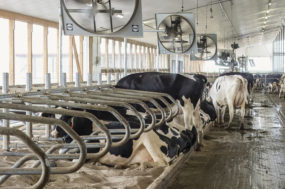Editor’s note: The following article summarizes an online survey being conducted on the use of tail docking. Do you dock the tails of cows on your farm? Do your neighbors? What do you think of this practice? Here is your chance to share your views with other readers by participating in an online tail docking survey. You can see online which answers (and the reasons behind these) are most popular. We will also report results back to readers in the next issue, summarizing the most popular reasons for agreeing and disagreeing with docking the tails of dairy cows.
Tail docking dairy cattle first became common in New Zealand, where workers thought this could reduce their risk of diseases like leptospirosis that can be carried by cows. Some milkers also preferred working with docked cows because the shortened tail was less likely to hit them in the parlor. Some people felt that docking improves cow cleanliness, and cleaner cows should be exposed to fewer pathogens and improved udder health.
There may also be disadvantages associated with docking. For some, at least, there is a ‘yuck’ factor of seeing cows without their tails. Docking might also cause pain, and prevents cows from using their natural fly swatter. For these reasons several European countries including Norway, Sweden, the Netherlands, the United Kingdom and Switzerland, have prohibited tail docking of dairy cattle. California passed legislation outlawing tail docking last year, and Canada’s Code of Practice for the Care and Handling of Dairy Cattle – distributed to all Canadian producers in 2009 – has a new requirement prohibiting tail docking unless medically necessary. PD
Dr. Dan Weary and Dr. Marina von Keyserlingk, professors at the University of British Columbia and well-known experts on the care and management of dairy cattle, are hosting this survey. In a follow-up article they will address the key issues that emerge from your comments.
Daniel Weary is a professor with theUniversity of British Columbia.



